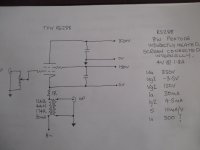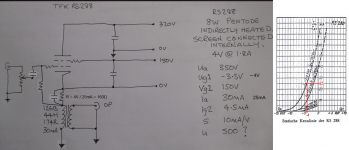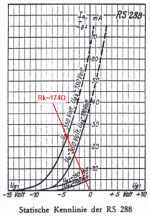Hi, This is my first post since '04, when I posted a few questions under the name John no nfb, I quickly realized I didn't have a clue what I was talking about, so went back to lurking, anyway fast forward, I still don't know what I'm talking about but now I just don't care if people think I'm stupid! My question is- I would like to see if I can use a TFK RS288 indirectly heated pentode as a transformer / choke loaded cathode follower ( a linestage) really I need to know what cathode resistance to get about 25mA through the device, I plan a floating screen supply, so no screen current through the trans/choke, I will attempt to post some specs and a rough idea of a circuit. Thanks John
Attachments
While I think you can make your design turn on and function, I don't think it will work like you think it will.
It won't have any gain, and all you will be doing is injecting a bunch of PSU noise into your audio.
I think you should look into triode strapping the tube and then take your output from the anode. That way you will have some gain, and you can use a really simple power supply.
It won't have any gain, and all you will be doing is injecting a bunch of PSU noise into your audio.
I think you should look into triode strapping the tube and then take your output from the anode. That way you will have some gain, and you can use a really simple power supply.
Thank you for your answers, I know there's no gain with a CF, the idea is low impedance to drive the 1:8 SUT in my power amps through a long lead. If I go with 160R as Mona suggest couldn't I just use the 174R of the 126B and leave out the capacitor ? I'm sure I've seen it done like this before. Thanks John
Yes, you could use the DC-resistance of the transformer to get the grid voltage.Thank you for your answers, I know there's no gain with a CF, the idea is low impedance to drive the 1:8 SUT in my power amps through a long lead. If I go with 160R as Mona suggest couldn't I just use the 174R of the 126B and leave out the capacitor ? I'm sure I've seen it done like this before. Thanks John
It's a bit more then the 160Ω for 25mA, but if you settle for 24mA ...
Mona
Attachments
Thank you for your answers, I know there's no gain with a CF, the idea is low impedance to drive the 1:8 SUT in my power amps through a long lead. If I go with 160R as Mona suggest couldn't I just use the 174R of the 126B and leave out the capacitor ? I'm sure I've seen it done like this before. Thanks John
Oh then you are really going to want lower output impedance than what you currently have.
You can try and triode strap the tube, replace the transformer with a single resistor and just have a capacitor output.
Or you can you the tube as is or triode strap it and use a line stage output transformer on the anode and try to drop the output impedance that way.
One way or another, I have to imagine that you want the output impedance to be 600 ohms or less.
According to the Ia-Vg1 graph the transconductance is about 7mA/V.
So the output impedance at the cathode is 1V/7mA=~140Ω
What you find at the output depends on the transformer ratio and loss.
Mona
So the output impedance at the cathode is 1V/7mA=~140Ω
What you find at the output depends on the transformer ratio and loss.
Mona
Tjj226's comments got me thinking, of course using a 5k:5k interstage could be an issue, and I didn't know the output impedance of the 288 used like this, Then Mona answered that one. In my naivety I thought the TX reflected it's source, so if it's low in, it's low out. I'm loath to use a resistor, I'd rather use the 126b as a choke (just 1 half) and cap couple the OP .I could do it with CCS's but I'd rather eventually use an OPT. Thanks John
If you leave the output of the transformer floating, no risk of ground loops.And can also be used for balanced input of an amplifier.
Mona
Mona
Thanks again Mona, I can see now that to use a step down OPT I would have to add gain at least equal to the step down ratio. Could you explain a little more on your comment about also doing balanced input to power amp, this is my reason for wanting TX output. Thanks John
The output of the transformer gives a signal as the difference between the two connections, no relation to ground.
If the amplifier needs a centre (ground) it's the responsability of the amp.
With a transformer input at the amplifier the connection is fully floating.In that case a resistor (>1MΩ) to ground on one of the leads (or a centre tap) to ground is best to prevent charge build-up.
Mona
If the amplifier needs a centre (ground) it's the responsability of the amp.
With a transformer input at the amplifier the connection is fully floating.In that case a resistor (>1MΩ) to ground on one of the leads (or a centre tap) to ground is best to prevent charge build-up.
Mona
- Home
- Amplifiers
- Tubes / Valves
- Introduction and Pentode CF question


